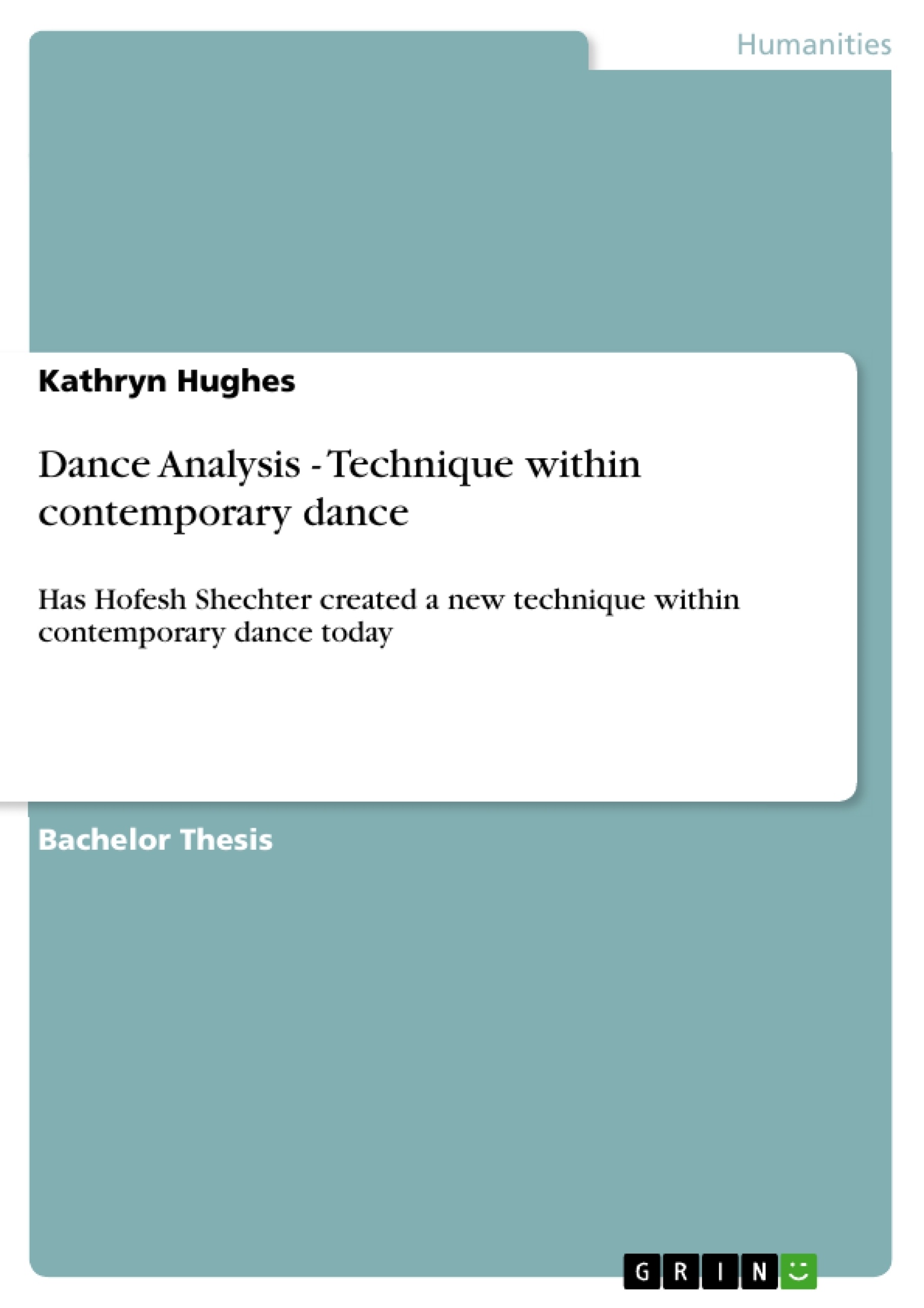This study investigates, through a detailed movement analysis of several choreographic works, whether Hofesh Shechter has created a new technique within contemporary dance today. The analysis utilises elements from both Adshead’s (1988) model for movement analysis and Stinson’s (2006) model for choreography: however adapting elements to consider the form and provide an evaluation through an external observation.
In conclusion this study has revealed that irrespective of era;
‘Art cannot be divorced from life – it is of life’s essence. The central subject matter of all art is emotional value not fact. The art which expresses emotional values in movement is dance. So to dance one must study and explore and know movement’
H’Doubler (1998, pxxix)
Table of Contents
- Extended introduction
- Research Process
- Critical Review
- Explicit Summary
- References
- Appendix, Acknowledgement
Objectives and Key Themes
This study aims to determine, through movement analysis of Hofesh Shechter's choreographic works, whether he has developed a novel technique in contemporary dance. The research uses existing models of movement and choreography analysis, adapting them to evaluate Shechter's style through external observation.
- Development of a new contemporary dance technique
- Analysis of Hofesh Shechter's choreographic style
- Application and adaptation of existing movement analysis models
- The relationship between art, life, and emotional expression in dance
- Evaluation of Shechter's work through external observation
Chapter Summaries
Extended introduction: This introductory section lays the groundwork for the study by establishing the context of Hofesh Shechter's work within contemporary dance. It introduces the influx of modern dance influences, discusses the concept of technique in dance, and provides background information on Hofesh Shechter himself. Crucially, it also introduces Shechter's perceived unique language of movement, the central question the study seeks to answer. This sets the stage for the research methodology and analysis that follow.
Research Process: This chapter outlines the research methodology employed in the study. It details the hypothesis, justifying the chosen research design and the process of analysis. This includes a description of the specific methods used for data collection and interpretation, establishing the framework for the critical review and subsequent findings. The justification section likely explains the rationale behind the selection of specific analytical models and the adaptation of pre-existing frameworks.
Critical Review: This section delves into a detailed movement analysis of Hofesh Shechter's choreographic work. It likely applies the methodologies described in the previous chapter to specific pieces, identifying and examining key movement patterns, structures, and stylistic choices. This in-depth analysis forms the empirical basis for evaluating whether Shechter has created a unique technique.
Keywords
Hofesh Shechter, contemporary dance, movement analysis, choreography, technique, modern dance, artistic expression, emotional value, external observation, research methodology.
Frequently Asked Questions: A Comprehensive Language Preview of Hofesh Shechter's Choreographic Technique
What is the main objective of this study?
This study aims to determine if Hofesh Shechter has developed a novel technique in contemporary dance through a movement analysis of his choreographic works. It utilizes existing models of movement and choreography analysis, adapting them to evaluate Shechter's style through external observation.
What are the key themes explored in this research?
The key themes include the development of a new contemporary dance technique, analysis of Hofesh Shechter's choreographic style, application and adaptation of existing movement analysis models, the relationship between art, life, and emotional expression in dance, and evaluation of Shechter's work through external observation.
What is covered in the "Extended Introduction" chapter?
The extended introduction sets the context of Hofesh Shechter's work within contemporary dance. It discusses the influence of modern dance, the concept of technique in dance, provides background information on Shechter, and introduces his perceived unique movement language, establishing the central research question.
What methodology is described in the "Research Process" chapter?
This chapter details the research methodology, including the hypothesis, research design, data collection and interpretation methods, and justification for the chosen analytical models and adaptations of pre-existing frameworks. It establishes the framework for the critical review and findings.
What does the "Critical Review" chapter entail?
The critical review chapter provides a detailed movement analysis of Hofesh Shechter's choreographic work. It applies the methodologies outlined earlier to specific pieces, examining key movement patterns, structures, and stylistic choices to evaluate whether Shechter has created a unique technique.
What are the key chapters included in the study?
The study includes an extended introduction, a chapter detailing the research process, a critical review, an explicit summary (not detailed in the preview), references, and an appendix with acknowledgements.
What are the keywords associated with this research?
Keywords include Hofesh Shechter, contemporary dance, movement analysis, choreography, technique, modern dance, artistic expression, emotional value, external observation, and research methodology.
What kind of analysis is used in this study?
The study employs movement analysis, focusing on the observation and interpretation of Shechter's choreographic works to determine if he has developed a unique dance technique.
What is the overall structure of this document?
The document provides a comprehensive preview including a table of contents, objectives and key themes, chapter summaries, and keywords.
- Citar trabajo
- Kathryn Hughes (Autor), 2011, Dance Analysis - Technique within contemporary dance, Múnich, GRIN Verlag, https://www.grin.com/document/208125



